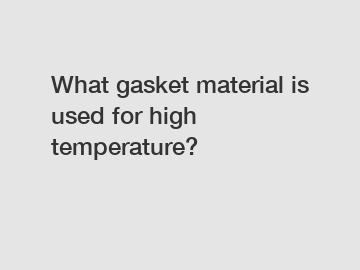What gasket material is used for high temperature?
What gasket material is used for high temperature?
High temperatures can pose numerous challenges in various industries, requiring specialized materials that can handle extreme heat and pressure. One such material commonly used for high-temperature applications is graphite. This article will explore the reasons behind graphite's popularity as a gasket material, the process that validates its suitability, and the significant impact it has in diverse fields.
Graphite, a form of carbon, is highly regarded for its exceptional thermal resistance and stability. Its unique structure, consisting of layered sheets of carbon atoms, makes it an excellent choice for high-temperature environments. These layers are held together by relatively weak Van der Waals forces, enabling them to easily slide over one another when subjected to thermal stress. This property gives graphite its remarkable ability to withstand thermal expansion and contraction, making it a reliable option for sealing applications at elevated temperatures.

To determine the suitability of graphite as a gasket material for high-temperature conditions, various tests and evaluations are conducted. One crucial test is the measurement of thermal conductivity. Graphite exhibits high thermal conductivity, enabling it to efficiently dissipate heat and prevent localized hotspots. Another critical parameter is its resistance to oxidation. Graphite has a minimal reaction with oxygen and is considered self-lubricating. This inherent resistance to oxidation makes it highly durable and long-lasting even when exposed to high temperatures for extended periods. Additionally, graphite gaskets undergo compression and recovery tests to ensure their ability to maintain an effective seal under extreme conditions.
The use of graphite gasket material in high-temperature environments has far-reaching implications across a wide range of industries. One significant area is the chemical industry, where volatile substances and high process temperatures are common. Graphite gaskets provide a reliable sealing solution, preventing leaks and minimizing the risk of accidents or equipment failures. In the oil and gas sector, graphite gaskets play a crucial role in high-pressure and high-temperature applications, ensuring the integrity of pipelines and equipment. Moreover, in power generation plants, graphite gaskets are utilized in flange connections and heat exchangers, enabling efficient heat transfer and reducing energy losses.
The impact of graphite gasket materials extends beyond their functional properties. Their use contributes to enhanced operational efficiency, reduced downtime, and increased safety. The reliability and longevity of graphite gaskets reduce the need for frequent maintenance and replacement, resulting in cost savings for industries that operate in high-temperature environments. Additionally, the ability of graphite to prevent leaks and maintain a secure seal helps prevent environmental contamination and promotes sustainability.
In conclusion, graphite gasket material is widely used for high-temperature applications due to its superior thermal resistance, stability, and self-lubricating properties. Validated through various tests, its suitability for extreme conditions is undisputed. The impact of graphite gaskets is significant, as they provide reliable sealing solutions across industries such as chemical, oil and gas, and power generation. This material contributes to operational efficiency, cost reduction, and environmental protection. Ultimately, the choice of graphite as a gasket material for high temperatures ensures safety, reliability, and longevity in demanding industrial settings.
If you want to learn more, please visit our website High Abrasion Resistance Nr Rubber Sheet for Sale, Hammer Top Cow Rubber Mat, China Cow Rubber Mat.
246
0
0

Comments
All Comments (0)